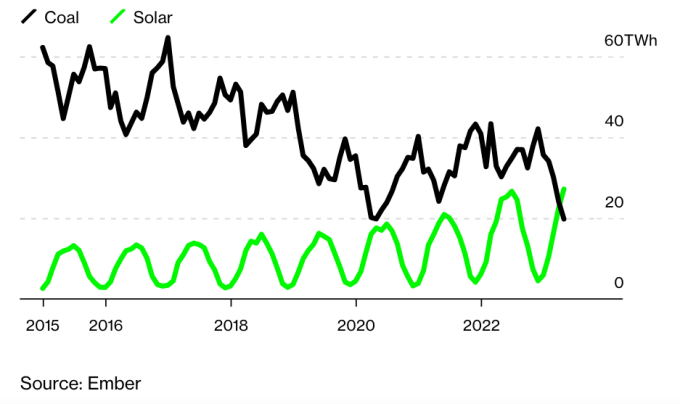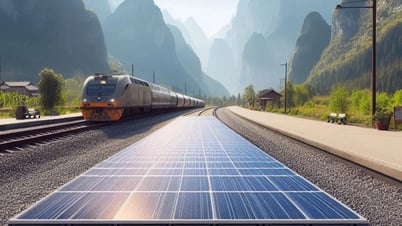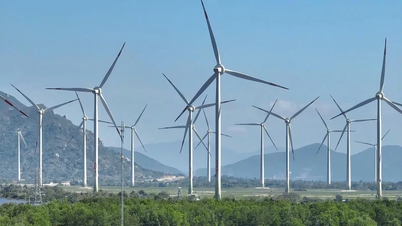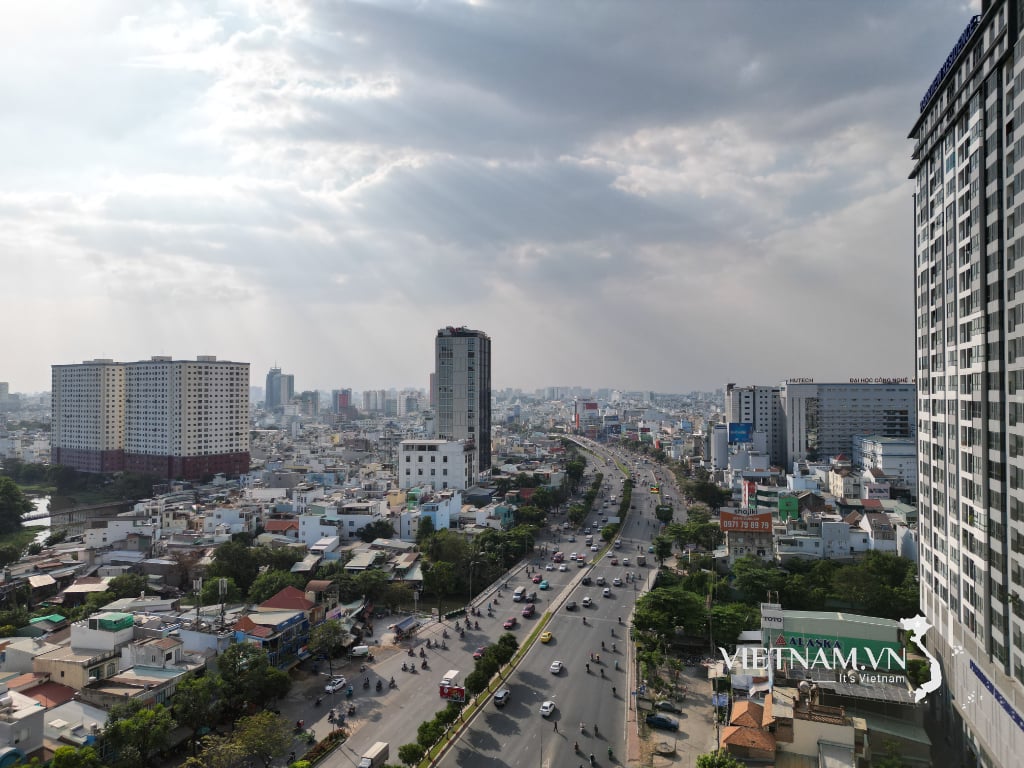May marked the first time solar power output surpassed coal power in Europe, even though the summer peak has not yet arrived.
In early May, the total solar power output reached 27.9 Twh, while all thermal power plants produced 19.8 Twh. Since December 2022, coal power has had a total capacity of 42.1 Twh and has been decreasing since then. In contrast, after a low output cycle due to winter, solar power output has increased continuously from 4.5 Twh.
Nowhere is the solar boom more pronounced than the Netherlands. There are more than 100 megawatts of solar panels for every 100,000 inhabitants, twice as many as in Spain and more than three times as many as in China.

Solar (green) and coal (black) power generation in Europe. Graphic: Bloomberg
The Netherlands has the world’s densest solar grid thanks in large part to long-term government support, which rewards households for installing solar panels and deducts from their electricity bills the amount they produce, regardless of when they use the power.
Jorrit de Jong, a spokesman for grid operator TenneT, says the Dutch government has been an overwhelming success with the incentive program. “If I do laundry or charge my car when the sun is not shining, it doesn’t matter because the electricity company still pays,” he explains. He also has seven solar panels on his roof, which cover 80% of his household’s consumption.
The Dutch government plans to change the incentive scheme from 2025 with a gradually decreasing deduction. By 2031, households will only benefit from the energy they actually consume and will not be entitled to any additional deductions.
Across Europe, many countries are following the Dutch example. Since the conflict in Ukraine began, the installation of solar panels in the EU has accelerated. Unlike wind, hydro or geothermal power, the main advantage of solar power is that it can be installed quickly.
The rapid expansion of solar power bodes well for Europe’s efforts to wean itself off fossil fuels. But it has also exposed some weaknesses. Wholesale electricity prices have plunged into negative territory on some of the sunniest days of the past month, due to a glut of electricity.
Kesavarthiniy Savarimuthu, an analyst at BloombergNEF, said Europe will get a message from the future this summer. “The biggest message will be that we are not ready,” he said.
Solar power is a quick and easy solution to the energy crisis as Russian gas supplies dry up. But the downside is that output is best during the sunny months, when heating demand is typically low. Battery storage or green hydrogen systems are not yet advanced enough to harness solar power for nighttime lighting or winter heating.
Although record solar and wind output has helped phase out coal and gas plants at an impressive pace this year, the EU still has a long way to go to reach its 2050 net-zero emissions target.
Germany is under even more pressure, with a target of decarbonizing its electricity grid by 2035. Achieving that will require not only a massive expansion of clean energy sources, but also more appropriate changes in how it is consumed.
There are signs of a mismatch between supply and demand. Last weekend, wholesale electricity prices briefly turned negative as solar output hit a record in Germany. Negative prices are not unprecedented and are often caused by strong winds at night or on weekends, when demand is low.
Axel Thiemann, CEO of Sonnedix, one of Europe’s largest solar developers, said increasing price volatility and a growing frequency of low or negative prices could put further investment in renewables at risk. Sonnedix has nearly doubled the number of projects in Europe since the end of 2021, but Thiemann warned that development will be difficult without changes to how electricity is managed.
To better accommodate the fluctuating output of renewables, Europe needs a more flexible electricity system, something that was not necessary when nuclear and coal power could ramp up and down as demand dictated.
“Our current electricity system is not designed for these types of flexible demands,” said Thorsten Lenck, project manager at Berlin-based consultancy Agora Energiewende.
There are many ways to adapt. For example, developing grid-connected battery storage infrastructure that charges during the sunniest or windiest times and sells electricity back when production is low. Consumers could also be encouraged to use energy during peak and surplus production periods. That could be especially important as more electric vehicles hit the road.
Joke Steinwart, an analyst at Aurora Energy Research, predicts unprecedented solar production this summer, which is likely to increase volatility in electricity prices. “This presents huge opportunities for flexible technologies like batteries,” he said.
Phien An ( according to Bloomberg )
Source link





































![[Photo] Overcoming the heat, practicing to prepare for the parade](https://vphoto.vietnam.vn/thumb/1200x675/vietnam/resource/IMAGE/2025/6/21/b93392e8da8243b8a32040d19590e048)
























![[Maritime News] Wan Hai Lines invests $150 million to buy 48,000 containers](https://vphoto.vietnam.vn/thumb/402x226/vietnam/resource/IMAGE/2025/6/20/c945a62aff624b4bb5c25e67e9bcc1cb)












































Comment (0)